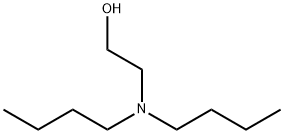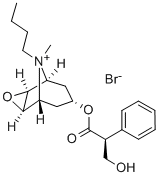N,N-Dibutylethanolamine , 99% , 102-81-8
Synonym(s):
N,N-Dibutylethanolamine
CAS NO.:102-81-8
Empirical Formula: C10H23NO
Molecular Weight: 173.3
MDL number: MFCD00014033
EINECS: 203-057-1
PRODUCT Properties
| Melting point: | -70°C(lit.) |
| Boiling point: | 229-230 °C(lit.) |
| Density | 0.86 g/mL at 25 °C(lit.) |
| vapor density | 6 (vs air) |
| vapor pressure | 5Pa at 20℃ |
| refractive index | n |
| Flash point: | 197 °F |
| solubility | Practically insoluble in water |
| form | Colorless liquid |
| pka | 14.77±0.10(Predicted) |
| color | Colorless to Light orange to Yellow |
| Water Solubility | 4g/L at 20℃ |
| BRN | 1738441 |
| Stability: | Stable. Combustible. Incompatible with strong oxidizing agents. |
| InChIKey | IWSZDQRGNFLMJS-UHFFFAOYSA-N |
| LogP | 1.86 at 20℃ |
| CAS DataBase Reference | 102-81-8(CAS DataBase Reference) |
| EPA Substance Registry System | 2-(Dibutylamino)ethanol (102-81-8) |
Description and Uses
2-Di-n-butylaminoethanol is a colorless toyellowish liquid. Faint amine-like odor. Molecularweight = 173.33; Boiling point = 224-232℃; Freezing/Melting point = ,269℃; Flash point = 96℃; Autoignitiontemperature = 240℃. Explosive Limits: LEL = 0.9%;UEL = 5.5%. Hazard Identification (based on NFPA-704 MRating System): Health 3, Flammability 2, Reactivity 0.Solubility in water = 11.6 g/L at 25℃.
2-(Dibutylamino)ethanol (DBAE) may be used as a coreactant to enhance the electrochemiluminescence (ECL) of tris(2,2′-bipyridyl)ruthenium(II) [Ru(bpy)32+], employed in the ECL immunoassays and DNA probe assays. DBAE may also be used as a catalyst during the synthesis of protected D-erythro-(2S,3R)-sphingosine.
Safety
| Symbol(GHS) |   GHS05,GHS07 |
| Signal word | Danger |
| Hazard statements | H302+H312-H314-H335-H412 |
| Precautionary statements | P261-P273-P280-P301+P312-P303+P361+P353-P305+P351+P338 |
| Hazard Codes | C |
| Risk Statements | 21/22-34 |
| Safety Statements | 26-36/37/39-45 |
| RIDADR | UN 2873 6.1/PG 3 |
| OEB | A |
| OEL | TWA: 2 ppm (14 mg/m3) [skin] |
| WGK Germany | 1 |
| RTECS | KK3850000 |
| HS Code | 2922.19.9690 |
| HazardClass | 6.1(b) |
| PackingGroup | III |



